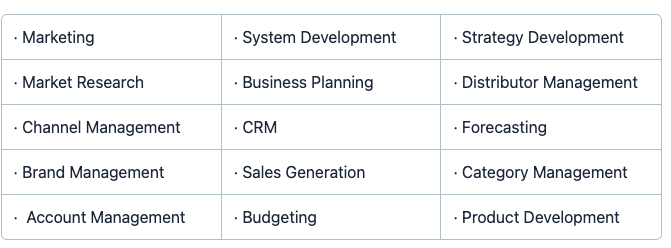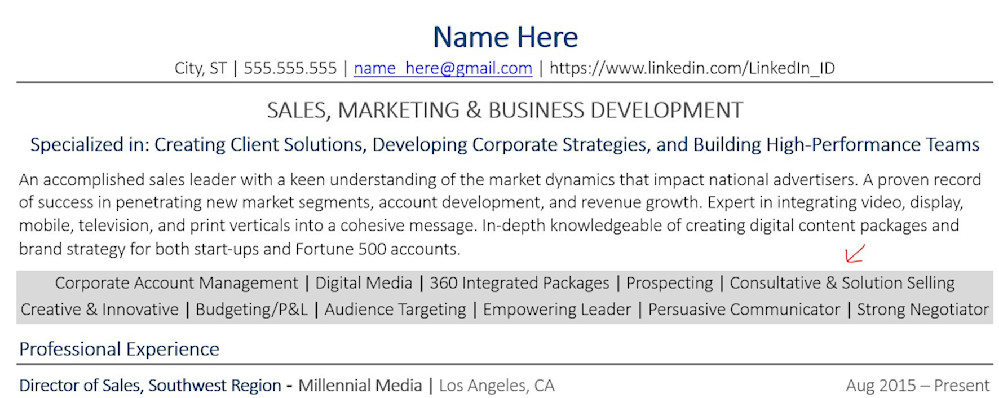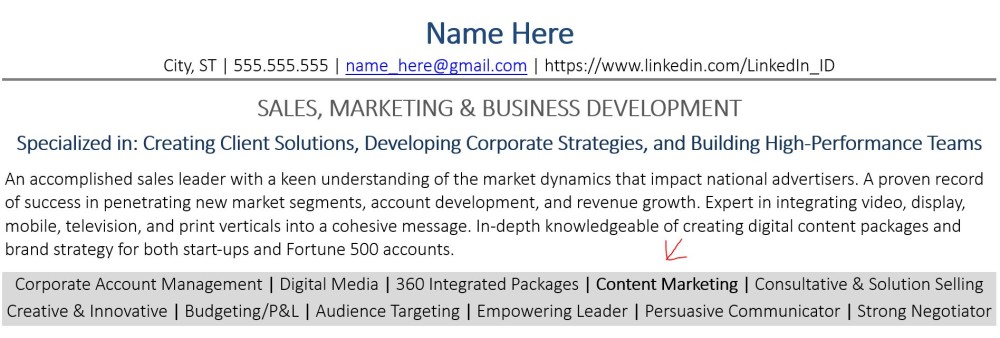
You’re competent. Of course you are.
But being competent is a bit like being proficient, being capable, or being average. No one wants that. It sounds boring, doesn’t it? A bit pedestrian. We all want to shine in our own way. And that is what we want to project onto our resume--our strengths, our fabulous assets, our star quality. If you can’t shout about how wonderful you are on your resume, then where can you shout about it?
There are five basic sections that are standard for a resume and that are the most important to have on there. Even if you do not have a lot to put in one of these sections, it is vital that you do put something.
So, in order, running down the resume starting from the top, they are the contact details, the Professional Profile, the Core Competencies section, the Career Summary, and the Education section. Extra sections you might want to add include Professional Development & Qualifications, such as relevant courses and workshops, awards (though steer clear of adding on your 50m swim certificate from kindergarten), Languages and the level you speak them, and any IT Proficiency.
But as long as you have the five major sections, you’re good to go.
The core competencies section
However, a lot of job seekers bypass one of these sections simply because it wasn’t seen as being a section on a resume in its own right until fairly recently.
This all changed when applicant tracking systems came onto the scene.
We’re talking about the core competencies section of a resume. It is often the most overlooked part of this job search document. And yet it holds so much sway and influence as it can really help you stand out to both hiring managers and computer algorithms. Applicant tracking systems are utilized by most employers nowadays. These work by the system automatically screening resumes to determine if applicants are a good match for the role on offer. The core competencies section on your resume is the perfect place to highlight the best skills you have as an applicant that the employer is seeking.
Every resume today should include a core competencies section, yet very few job seekers make good use of one.
If you are not sure how to go about creating core competencies on a resume, you have come to the right place. We will show you what a core competencies section is, how to include one, and throw in some great examples for good measure.
What are core competencies on a resume?
The core competencies on a resume are your core hard skills and competencies that relate to the position you’re applying for. This section is normally located just underneath your Professional Profile. It’s the top four inches on a resume that is the most important, as it is the first part to be seen. That means it has got to grab the attention of the hiring manager straightaway. If they like what they see initially, they will hopefully carry on reading the rest of your resume.
The core competencies on your resume should be listed in bullet points, or with dashes in between, but not in sentences.
Like this:
Core Skills & Competencies

Or like this:
Project Management | Project Delivery | Full Project Lifecycle | Client Engagement | Process Improvement | Risk Assessment | Issue Resolution | Strategic Planning | Stakeholder Engagement | Change Management | Resource Management | Budget Control | Leadership | Best Practice | Team Building | Line Management |
Keeping it short will make it clear, concise, and more ATS friendly--which we’ll discuss in more detail at the end of this post.
Why is the core competencies section important?
It catches the hiring manager’s attention
Your core competencies quickly tells the hiring manager how well you are qualified for the role, and what you can do. Bear in mind that your resume is only skimmed over for a few seconds before the hiring manager decides whether to reject your resume or look at it in more detail. A core competencies section allows you to quickly show the hiring manager that you’re a perfect fit for the position.
It gets you past the ATS scans
An ATS system screens your resume for keywords and other information to determine if you’re a good match for the position. Why does this matter? Because over 90% of employers utilize an ATS and they reject over 75% of resumes submitted.
The core competencies section is designed so that it contains the keywords and phrases that the ATS may be searching for. It’s also really useful because you can tailor your resume for different positions by swapping keywords in and out.
Examples of core competencies on a resume
Here is an example of what a core competencies section on your resume should look like:

As you can see, this is a resume for someone in the sales and marketing field. It quickly and concisely shows the hiring manager what skills and knowledge the candidate possesses without having to dig into the work experience section.
Once a hiring manager sees that the candidate’s information is relevant, they are more likely to read the resume in more detail.
Let’s take a look at how we can quickly tailor this to another position.
Another marketing position becomes available which also interests this candidate. This time “Content Marketing” is listed as a required skill. We can simply remove a less relevant skill and include “Content Marketing” instead.
Take a look now:

You can see that customizing your resume is much easier with a core competencies section. If this resume was then run through the ATS, and it was searching for that particular term, it would rank the resume as a good match for the position.
Expert Tip
Pro Tip: Do not use buzzwords or phrases such as “goal oriented” or “problem solver” within the core competencies section. Hiring managers are really put off by seeing these overused soft skills on a resume. Stick to hard skills and keywords that are relevant to the industry and the position you are applying to.
How to identify the right core competencies
You need to find the right competencies to include if you want to stand out and get past an ATS system. So, how to do this?
Step 1: Come up with a list of skills that relate to the position or industry that you are targeting.
Step 2: Meticulously check through the job description of the position you want to apply for.
Step 3: Pick out the keywords and phrases from the job description
Step 4: Add them to your core competencies section underneath your Professional Summary, but only if they apply to you, and only if you possess each particular skill.
Expert Tip
Pro Tip: You don’t need to change every single one when applying for different positions, as a lot of them can be used for several different applications, if you’re applying for similar roles. However, you should be swapping a few in and out every time to ensure your resume stays tailored and focused.
Core Competencies Examples
Here is an example of what a jobseeker in sales might include:
Strategic Market Planning
Business Development
Community Relations
Territory Development
Team Leadership
Team Management
Customer Service
Customer Engagement
Marketing Strategies
Brand Development
Staff Training
Staff Development
The below are core competencies from the resume of a nurse.
Healthcare Management
Healthcare Development
Nursing Management
Nursing Development
Mental Health Management
Patient Engagement
Palliative Care
Mentoring
Training
Relationship Building
Care Planning
Complex Care Management
Risk Assessments
Safeguarding
Another example below is for a Phys Ed teacher.
Phys Ed Teaching
Teaching & Learning
Educational Management
Educational Development
Classroom Management
Pupil Engagement
Pupil Attainment
Pupil Progress
Behavior Management
Leadership
Differentiation
Problem Resolution
Safeguarding
Mentoring
Coaching
Staff Engagement
People Management
And finally, here are the core competencies in the resume of a plant operator in the construction industry.
Plant Operation
Telehandler Operation
Laboring
Building Maintenance
Strategic Planning
Maintenance Management
Grounds Works
General Maintenance
Manual Labor
Installations
Time Management
Problem Resolution
Team Work
What about specialized or technical core competencies?
While it is normally best to steer clear of including any jargon in your resume, if you do possess niche skills that fit perfectly with the job advert, then including them is the way to go. These can include skills such as IT programs that you are proficient in, any medical terminology, and scientific terms.
If you use acronyms, such as CRM for Customer Relationship Management, it is best to spell these out for the ATS.
Failsafe tips for writing your core competencies
Keep it short. Don’t use full sentences as this isn’t as clean and concise as short, punchy keywords. Stick to one or two words for each skill.
List it under the summary. Listing your core competencies under your resume summary makes it easy to spot at first glance. You want to capture the hiring manager's attention from the start and show that you’re a good match for the position.
Tailor your resume. You should be swapping keywords in and out for each position you apply for. Look at the job description to get ideas of keywords that the applicant tracking system would be looking for. Major responsibilities and skill requirements from the job description should be listed in your resume.
Don’t stuff your resume full of keywords. You might be under the impression that the more you fill your resume with keywords, the higher your resume will rank in an applicant tracking system test. This is a myth. As quickly as an ATS rejects a resume without any relevant keywords, it also rejects ones that are stuffed with tons of them. Keep it to between 9 and 12 core competencies, with additional skills threaded throughout the resume in the Career Summary section.
Next steps
A core competencies section can really help give your resume the boost it needs, and set you apart from the rest of the competition. It allows you to pass ATS systems and capture the attention of a hiring manager, quickly and easily. Just remember to tailor your resume with relevant keywords for each position you apply for.
The best of luck with your job search.
Having your core competencies on a resume really screams out to a recruiter that you’re the one for the job…as long as they are relevant. It’s vital that you check this every time. For a heads up on how your resume fares, give ZipJob’s free resume review tool a go. It will give you pointers on where to improve your resume, so you will be raring to go next time you apply for a job.
Related posts:

Written by
Elizabeth Openshaw, Editor & Content Writer, Elizabeth Openshaw, Editor & Content Writer
Elizabeth Openshaw is an Elite CV Consultant with over 12 years of experience based in Brighton, UK, with an English degree and an addiction to Wordle! She is a former Journalist of 17 years with the claim to fame that she interviewed three times Grand Slam winner and former World No.1 tennis player, Andy Murray, when he was just 14 years old. You can connect with her at Elizabeth Openshaw | LinkedIn.
